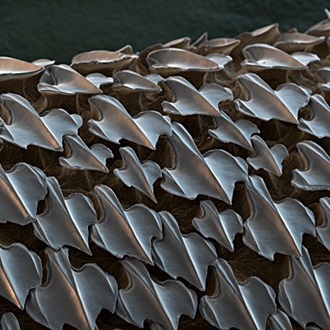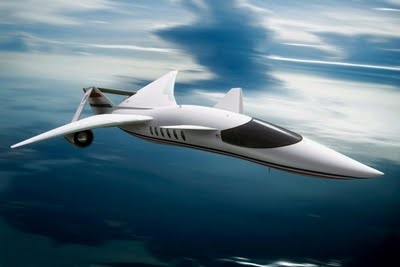Contact Disruptive Surface
I have noted from mother nature that some evolutions have given rise to reductions to resistance in fluid motion. Two design system are of particular intererst:
1. Shark’s skin is covered in a rough surface of a particular scale. [Placoid scales or dermal dendrites] At speed this rough surface reduces hydrodynamic resistance.
2. The bumble bee’s large unaerodynamic body flies sucessfully with a ratio of very small wings. Seemingly defying normally expected flight paraeters.
Background:
1. Shark skin is rough to the touch. It is made up of placoid scales or dermal denticles. [Pic 1] At slow speeds the water drags over the rough surface. But at higher speeds 20–30+ knots [A sweet speed range] the shape of the scales makes the water layer in contact with the skin, tumble over and over, forming a rolling conveyor of highly agitated water [not unlike a plasma or flux state in behavior] This rolling-layer produces a reduction in contact density, allowing the shark to speed into a reduced drag-energy state, for the conservation of energy, during its high energy attack hunting phases. Or a sudden increase causes the skin shape to enter a hydrodynamic sweet [slip] speed range.
2. The question of the physics of the bumble bee in flight has been a subject of discussion for many years. The bumble bee seems to break all of the principles of aerodynamics. It is big round and hairy with wings that are too small and that should not make flight possible. When in fact the bumble bee can fly well for some kilometers. [Pic 2] It has been proposed that the bee uses brute force to overcome its aerodynamic problems. What is certain is that the bumble bee was not given a bum deal by evolution but was given a solution to its apparent flight restrictions. Around its round bulbous body it is covered in bristly hairs. As the bee takes to the air it buzzes. This buzzing vibrates the bristly hairs and causes the air between them to vibrate introducing an agitated flux state, to the air in the intermediate spaces and including a peripheral distance beyond the hair tip. In so doing a layer of air in flux is created around the bee to separate the bee from the ambient air density resistance. Using this physics the bee never needed to develop bigger wings. The efficiency of flow reduced the bees vulnerability of having lager wings. Better to maneuver around flowers, less of a soft target for predators and far better overall for the conservation of energies.
Water: Water is 800 times more dense than air at sea level. This high density [and probably molecular cohesion] causes a problem for a [flux state] to occur. The shark {I think} is creating a partial flux state [more like a low contact tumble]. This low contact tumble should be reproducible on the hulls of ships. The whale sharks dermal denticles are larger than on smaller sharks but not overtly so. The whale shark has no kill speed so therefore the denticles maybe a left over from its predatory beginnings and retained as some efficiency in movement is still derived. The point being that if the whale shark were to have a kill speed, the denticles would probably be flatter and therefore a different shape for a higher speed surface disruption.
Ships have large hulls travelling slowly. Ships have positive buoyancy creating a higher surface contact pressure than a fish. In order to create a product [in the first instance] making a ship [cargo] move through the water more efficiently [using reduced propulsion for average speed] at 15-18 knots, dendrite should be large [length 1-2cm] and have a higher ridged centre curving through its length. For faster [military etc] vessels the [base line] should be flatter to create the hydro undulation at [speed] to cause the low contact tumble. This will both allow for reduced propulsion and or increased speed for no increase in cost or reduction in range. Vibrations are unlikely to be applicable [or enhance] for hydro dendrites.
Air: The [bumble bee] is creating a flux state within its hairs, under vibration at sea level air pressure and at a specific speed range. In order to create a flux state at higher speeds and pressures, a calculation from a [base line] will need to take a consideration of a speed to air pressure ratio. This will determine shape size and rigidity of the repeating placoids. Hairs being unlikely to be of any applicable use to human / drone travel [beyond proof of concept].
Placoids should be manufacturable for air use to flex / flatten to create / elongate the speed range sweet / flux state. Two speed rages / altitudes for the price of one placoid. Vibrations are likely to be of more use for slower speeds 200-500 knots. Above this a lighter agitation for fluidic flow will enhance the placoids repeating size shape to establish target flux state.
Because air is 800 times less dense than water. At sea level air pressure, I think a good size of scale to start with would be about 4mm square & 2mm risen. The rigidity of the scales will be key to both air tumble and vibration. A tail / spring could be designed in to eliminate the need for a separate energy source to produce the vibrating effect. At speed the curved tail would create the desired effect. I think a good fabric to try in the first instance would be nylon (as in wash bowl) If a layer of such nylon dendrites were to be molded on a sheet that could be stuck on to a surface in a wind tunnel [with adjustments and perhaps in the proving phase, a vibrating source] you may see an invention.
I think that the most useful vehicle uses would be for high speed trains and aircraft at an altitude to reduce the energy needed for a varied number of speeds and too increase cruising speed beyond the second engineering barrier of mach3, without the engineering expense or propulsion previously required. In theory a light executive jet could be designed to have two sweet speed ranges at two altitudes, with one surface size. One speed going mac1+ at 40,000ft and the staying in the flux range, as the vehicle accelerated and climbed to lower pressure and mach2+ with a new minimum of engine power required.





